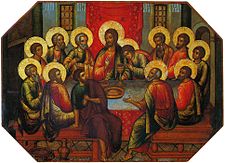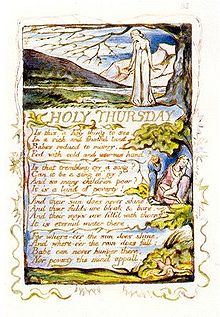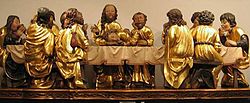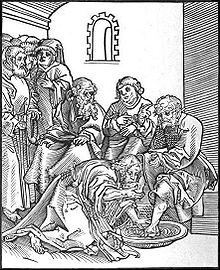- Maundy Thursday
-
Maundy Thursday 
The Mystical Supper, Icon by Simon Ushakov (1685).Also called Holy Thursday
Covenant Thursday
Great and Holy Thursday
Thursday of MysteriesObserved by Christians Type Christian / Civic Significance commemorates the Last Supper of Jesus Christ 2011 date 21 April 2012 date 5 April Observances Service of Worship / Mass; distribution of Maundy money Related to Holy Week "Holy Thursday" redirects here. For the celebration forty days after Easter, see Ascension Day.Maundy Thursday, also known as Holy Thursday, Covenant Thursday, Great & Holy Thursday, and Thursday of Mysteries, is the Christian feast or holy day falling on the Thursday before Easter that commemorates the Last Supper of Jesus Christ with the Apostles as described in the Canonical gospels. It is the fifth day of Holy Week, and is preceded by Holy Wednesday and followed by Good Friday.
The date is always between 19 March and 22 April inclusive, but these dates fall on different days depending on whether the Gregorian or Julian calendar is used liturgically. Eastern churches generally use the Julian calendar, and so celebrate this feast throughout the 21st century between 1 April and 5 May in the more commonly used Gregorian calendar. The Mass of the Lord's Supper initiates the Easter Triduum, the three days of Good Friday, Holy Saturday and Easter Sunday that commemorate the Passion, Death and Resurrection of Jesus.[1] It is normally celebrated in the evening, when Friday begins according to Jewish tradition.
Contents
Names in English
Use of the names "Maundy Thursday", "Holy Thursday" and the others is not evenly distributed. What is considered the normal name for the day varies according to geographical area and religious allegiance. Thus, while in England "Maundy Thursday" is the normal term, this term is rarely used in Ireland or Scotland in religious contexts. The same person may use one term in a religious context and another in the context of the civil calendar of the country in which he lives.
The Anglican Church uses the name "Maundy Thursday" in the Book of Common Prayer, whereas it treats "Holy Thursday" as an alternative name for Ascension Day.[2][3] But outside of the official texts of the liturgy, Anglicans sometimes apply the name "Holy Thursday" to the day before Good Friday.[4]
The Roman Catholic Church, even in countries where "Maundy Thursday" is the name in civil legislation, uses the name "Holy Thursday" in its official English-language liturgical books;[5] but, except in these texts, Roman Catholics will sometimes use "Maundy Thursday", especially in England.[6]
The United Methodist Church uses the name "Holy Thursday" in its UM Book of Worship,[7] but in other official sources it uses both "Maundy Thursday"[8][9] and "Holy Thursday".[10][11]
Both names are used by other Christian denominations as well, including the Lutheran Church[12][13][14] or portions of the Reformed Church.[15][16][17] The Presbyterian Church uses the term "Maundy Thursday" to refer to the holy day in its official sources.[18]
In the Eastern Orthodox Church, the name for the holy day is, in the Byzantine Rite, "Great and Holy Thursday"[19] or "Holy Thursday",[20][21] and in Western Rite Orthodoxy "Maundy Thursday",[22][23] "Holy Thursday"[24] or both.[25] The Coptic Orthodox Church uses both the terms "Maundy Thursday" and "Covenant Thursday" for the holy day.[26]
In the Maronite Church[27] and the Syriac Orthodox Church,[28] the name is "Thursday of Mysteries".
"Maundy Thursday" is the official name in the civil legislation of England[29] and the Philippines.[30]
The day has also been known in English as Sheer Thursday, from an obsolete word shere (meaning "clean" or "bright"). This name might refer to the act of cleaning, or to the fact that churches would switch liturgical colors from the dark tones of Lent, or because it was customary to shear the beard on that day,[31] or for a combination of reasons.[32] This name is a cognate to the word still used throughout Scandinavia, such as Swedish "Skärtorsdag", Danish "Skærtorsdag", Norwegian "Skjærtorsdag", Faroese "Skírhósdagur" and "Skírisdagur" and Icelandic "Skírdagur". Skär in Swedish is also an archaic word for wash.
Some secular communities refer to the day as "Easter Thursday", although technically, the correct day for this name is the following Thursday, after Easter.
Derivation of the name "Maundy"
Most scholars agree that the English word Maundy in that name for the day is derived through Middle English and Old French mandé, from the Latin mandatum, the first word of the phrase "Mandatum novum do vobis ut diligatis invicem sicut dilexi vos" ("A new commandment I give unto you, That ye love one another; as I have loved you"), the statement by Jesus in the Gospel of John (13:34) by which Jesus explained to the Apostles the significance of his action of washing their feet. The phrase is used as the antiphon sung during the "Mandatum" ceremony of the washing of the feet, which may be held during Mass or at another time as a separate event, during which a priest or bishop (representing Christ) ceremonially washes the feet of others, typically 12 persons chosen as a cross-section of the community.
Others theorize that the English name "Maundy Thursday" arose from "maundsor baskets" or "maundy purses" of alms which the king of England distributed to certain poor at Whitehall before attending Mass on that day. Thus, "maund" is connected to the Latin mendicare, and French mendier, to beg.[33][34] A source from the Lutheran Church–Missouri Synod likewise states that, if the name was derived from the Latin mandatum, we would call the day Mandy Thursday, or Mandate Thursday, or even Mandatum Thursday; and that the term "Maundy" comes in fact from the Latin mendicare, Old French mendier, and English maund, which as a verb means to beg and as a noun refers to a small basket held out by maunders as they maunded.[35]
Services
Western Christianity
The Washing of the Feet is a traditional component of the celebration in many Christian Churches, including the Armenian,[36] Ethiopian, Eastern Orthodox, Eastern Catholic, Schwarzenau Brethren/German Baptist groups, Mennonites, and Roman Catholic Churches, and is becoming increasingly popular as a part of the Maundy Thursday liturgy in the Anglican/Episcopal,[37] Lutheran, Methodist, and Presbyterian Churches,[9] as well as in other Protestant denominations. In the Roman Catholic Church, the Mass of the Lord's Supper begins as usual, but the Gloria is accompanied by the ringing of bells, which are then silent until the Easter Vigil.[38] After the homily the washing of feet may be performed. The service concludes with a procession taking the Blessed Sacrament to the place of reposition. The altar is later stripped bare, as are all other altars in the church except the Altar of Repose. In pre-1970 editions, the Roman Missal envisages this being done ceremonially, to the accompaniment of Psalm 21/22,[39][40] a practice which continues in many Anglican churches. In other Christian denominations, such as the Lutheran Church or Methodist Church, the stripping of the altar and other items on the chancel also occurs, as a preparation for the somber Good Friday service.[41]
Eastern Christianity
 Orthodox icon of Christ washing the feet of the Apostles (16th century, Pskov school of iconography).
Orthodox icon of Christ washing the feet of the Apostles (16th century, Pskov school of iconography).
In the Eastern Orthodox Church, the Lenten character of the services is for the most part set aside, and they follow a format closer to normal. The liturgical colours are changed from the somber Lenten hues to more festive colours (red is common in the Slavic practice). The primary service of this day is Vespers combined with the Liturgy of St. Basil the Great. At this service is read the first Passion Gospel (John 13:31-18:1), known as the "Gospel of the Testament", and many of the normal hymns of the Divine Liturgy are substituted with the following troparion:
Of Thy Mystical Supper, O Son of God, accept me today as a communicant; for I will not speak of Thy Mystery to Thine enemies, neither will I give Thee a kiss like Judas. But like the Thief will I confess Thee: Remember me, O Lord, in Thy Kingdom.
In addition to the usual Preparation for Holy Communion, the Orthodox faithful will often receive the Mystery of Unction on Great Wednesday as preparation for the reception of Holy Communion on Great Thursday. It is customary to cover the Altar table with a simple, white linen cloth on this day, as a reminder of the Last Supper. On Great Thursday, the Reserved Sacrament is customarily renewed, a new Lamb (Host) being consecrated for the coming liturgical year, and the remainder from the previous year is consumed. The ceremony of the Washing of Feet will normally be performed in monasteries and cathedrals. Because of the joy of the Institution of the Eucharist, on this day alone during Holy Week wine and oil are permitted at meals. Whenever there is need to consecrate more chrysm it will be done on this day by the heads of the various autocephalous churches. In the evening, after the Liturgy, all of the hangings and vestments are changed to black or some other Lenten colour, to signify the beginning of the Passion.
Beginning on Holy and Great Thursday, the celebration of the Lity (memorial service) is forbidden until Thomas Sunday (the Sunday after Easter).
Customs and names from around the world
- The Maundy Thursday celebrations in the United Kingdom today involve the Monarch (since 1952, Queen Elizabeth II) offering "alms" to deserving senior citizens (one man and one woman for each year of the sovereign's age). These coins, known as Maundy money or Royal Maundy, are distributed in red and white purses. This custom dates back to King Edward I. The red purse contains regular currency and is given in place of food and clothing. The white purse contains currency in the amount of one penny for each year of the Sovereign's age. Since 1822, rather than ordinary money, the Sovereign gives out Maundy coins[42], which are specially minted 1, 2, 3 and 4 penny pieces, and are legal tender. The service at which this takes place rotates around English and Welsh churches, though in 2008 it took place for the first time in Northern Ireland at Armagh Cathedral. Until the death of King James II, the Monarch would also wash the feet of the selected poor people. There is an old sketch, done from life, of Queen Elizabeth I washing people's feet on Maundy Thursday[citation needed].
- The popular German name Gründonnerstag means either "mourning Thursday" or "green Thursday".[43] Other names are Hoher, Heiliger, and Weißer Donnerstag (High, Holy and White Thursday, with "white" referring to the liturgical colour associated with Maundy Thursday).
- In the Czech Republic and Slovakia, the day is called Zelený čtvrtek or Zelený štvrtok respectively, again meaning "Green Thursday".[44] Because the church bells fall silent until Holy Saturday, here called "White Saturday", because "they have flown to Rome", in some regions they are replaced by groups of children walking round their village and making noise with wooden rattles. People come out of the door and give them money.
- The tradition of silent bells is found also in Luxembourg: the bells fall silent until Easter, because "they have flown to Rome for Confession", so children take to the streets, calling people to church with melancholy wooden rattling.[45]
Christus, by the Lutheran Lucas Cranach the Elder. This woodcut of John 13:14-17 is from Passionary of the Christ and Antichrist.
- In Malta, Holy Thursday is known as Ħamis ix-Xirka (Communion Thursday) and the tradition of visiting seven churches (see below) is called is-seba' visti.
- In Sweden Maundy Thursday (skärtorsdagen) is connected to old folklore as the day of the witches. Young children often dress up as witches and knock on doors getting coins or candy for easter eggs.
- In Bulgaria Maundy Thursday is called Veliki Chetvurtuk (Great Thursday), and is traditionally the day when people color their easter eggs and perform other household chores geared toward preparing for Razpeti Petuk (Crucifixion Friday), Velika Subota (Great Saturday) and Velikden (Easter Day).
- In Kerala, a state in south India where Saint Thomas Christians or Nasranis are in high population, this day is observed with great reverence. This day is called as Pesaha, a Malayalam word derived from the Aramaic or Hebrew word for Passover - Pasha or Pesah - commemorating the last supper of Jesus Christ during Passover in Jerusalem. This is also a state wide declared public holiday by the Government of Kerala. The tradition of consuming Pesaha appam or Indariyappam after the church service is observed by the entire Nasrani people till this day. Special long services followed by Holy Qurbana are conducted during the Pesaha eve or at mid-night till morning in the Syrian Christian churches. The Saint Thomas Christians or Nasranis are living all over the world including United States. They also celebrate this day as 'Pesaha Yasashchya' (Maundy Thursday) by having Holy Communion services in the parishes by following the liturgy of the respective denomiations from Kerala.
- In the Philippines, most business establishments cease operations from Holy Thursday to Black Saturday. Most malls, however, only cease their operations on Holy Thursday and Good Friday and only opens on Black Saturday. Terrestrial television and radio stations either go completely off-air during that period or operate limited hours where they broadcast special shows, usually themed for the Holy Week, which is not on their usual schedule. (Cable channels usually continue their normal telecasts as usual.) Newspapers usually have no issues during those days.
- If statues and crucifixes have been covered during Passion Time (the last 2 weeks of Lent, at least in the 1962 Roman Catholic missal), the crucifix covers are allowed to be white instead of purple for Holy Thursday.
Visiting seven churches
- The tradition of visiting seven churches on Holy Thursday is an ancient practice, probably originating in Rome, where early pilgrims visited the seven pilgrim churches as penance. They are Saint John Lateran, Saint Peter, Saint Mary Major, Saint Paul-outside-the-Walls, Saint Lawrence Outside the Walls, Holy Cross-in-Jerusalem, and traditionally Saint Sebastian Outside the Walls. Pope John Paul II replaced St. Sebastian with the Sanctuary of the Madonna of Divine Love for the jubilee year of 2000
- In the Philippines, the faithful carry out this tradition of Visita Iglesia (Spanish: Church visits) and some expand it to include fourteen churches and say the Stations of the Cross, with one station in each church.
- In several countries in Latin America it is also a tradition to visit seven churches on the night of Holy Thursday.
See also
- Corpus Christi
- Easter Triduum
- Friday before Palm Sunday
- Maundy
- Paschal cycle
- Tenebrae (service)
- Thursday of the Dead
References and footnotes
- ^ General Norms for the Liturgical Year and the Calendar, 19
- ^ "The Christian Year: Ascension Day". The Prayer Book Society of Canada. http://www.prayerbook.ca/bcp/propers.html#ascension. Retrieved 2009-04-11.[dead link]
- ^ "Tables and Rules for the Moveable and Immoveable Feasts". Scottish Episcopal Church. http://justus.anglican.org/resources/bcp/Scotland/Scot_Tables_Rules.htm. Retrieved 2009-04-11.
- ^ "Anglicans Prepare for Easter". The Anglican Communion Official Website. http://www.anglicancommunion.org/acns/news.cfm/2006/4/12/ACNS4135. Retrieved 2009-04-11.
- ^ "General Instruction of the Roman Missal, with adaptations for England and Wales". Catholic Bishops' Conference of England & Wales. http://www.liturgyoffice.org.uk/Resources/GIRM/Documents/GIRM.pdf. Retrieved 2009-04-11.
- ^ "Holy Thursday 2009". Roman Catholic Diocese of Hexham and Newcastle. http://www.rcdhn.org.uk/lent2009/maundythursday_supper09.php. Retrieved 2009-04-11.[dead link]
- ^ "United Methodist Book of Worship: Scripture Readings listed according to the Books of the Bible". General Board of Discipleship, The United Methodist Church. http://www.gbod.org/worship/default.asp?act=reader&item_id=8893&loc_id=733. Retrieved 2009-04-11.
- ^ "Holy Week Service for Midweek, Maundy Thursday, or Good Friday". United Methodist Church. http://www.gbod.org/worship/default.asp?act=reader&item_id=1850&loc_id=1,32,49. Retrieved 2009-04-05.
- ^ a b "Maundy Thursday". United Methodist Church. http://archives.umc.org/interior.asp?ptid=1&mid=2873. Retrieved 2009-04-05.
- ^ "Preaching Helps for Holy Thursday, Year B (April 17, 2003)". United Methodist Church. http://www.gbod.org/worship/preaching/articles.asp?act=reader&item_id=7701&loc_id=1,32,49. Retrieved 2009-04-13.
- ^ "Worship Planning Helps for Holy Thursday (April 8, 2004)". United Methodist Church. http://www.gbod.org/worship/worship/articles.asp?act=reader&item_id=10486&loc_id=9,32,49,975. Retrieved 2009-04-13.
- ^ "What is Holy Thursday?". University Lutheran Chapel, Lutheran Church–Missouri Synod. http://www.ulcboulder.org/archive/Maundy%20Thursday%20What%20Is.pdf. Retrieved 2009-04-11.
- ^ "Maundy Thursday". Historic Trinity Lutheran Church, Detroit. http://www.historictrinity.org/maundythursday.html. Retrieved 2009-04-11.
- ^ "Counting. A little history of how '40 Days of Lent' came to be". The Lutheran, the magazine of the Evangelical Lutheran Church in America. http://www.thelutheran.org/article/article_buy.cfm?article_id=7022. Retrieved 2009-04-11.
- ^ "Maundy Thursday". Reformed Church in America (RCA). http://www.rca.org/Page.aspx?pid=2615. Retrieved 2009-04-11.
- ^ "Calendar 2009 Year of the Reformer John Calvin". The Hungarian Reformed Church in the US and Diaspora. http://www.reformatus.us/liturgy/hungarian-reformed-church-calendar-2009-year-of-the-reformer-john-calvin/. Retrieved 2009-04-11.
- ^ "Calendar". Suydam Street Reformed Church. http://suydamstreetreformedchurch.org/calander_mar2008. Retrieved 2009-04-11.
- ^ "Middle East churches issue call to prayer on Maundy Thursday". Presbyterian Church (U.S.A.). http://www.pcusa.org/pcnews/2007/07187.htm. Retrieved 2009-04-05.
- ^ "Great and Holy Thursday". Greek Orthodox Archdiocese of America. http://lent.goarch.org/holy_thursday/learn/. Retrieved 2009-04-05.
- ^ "Great Lent: Theology, Homilies, Services, Resources". St Nicholas Russian Orthodox Church, McKinney (Dallas area) Texas. http://www.orthodox.net/greatlent/. Retrieved 2009-04-12.
- ^ "The Historical Development of Holy Week Services In the Orthodox/Byzantine Rite". Antiochan Orthodox Christian Archdiocese of North America. http://www.antiochian.org/midwest/Articles/Development_of_Holy_Week_Services.htm. Retrieved 2009-04-12.
- ^ "Saint Mark's Church: An Antiochian Orthodox Parish in the Western Rite Tradition". Western Orthodox. http://www.westernorthodox.com/stmark/bulletin/bulletin_040509.PDF. Retrieved 2009-04-11.
- ^ "Oratory of Our Lady of Glastonbury: Western Rite Orthodox Outreach to Southern Ontario". Oratory of Our Lady of Glastonbury. http://www.westernorthodox.ca/files/Christminster_Calendar_2009_2.pdf. Retrieved 2009-04-11.
- ^ "Orthodox Liturgical Index". The Society of Clerks Secular of Saint Basil. http://www.reu.org/public/liturgys/litidx.htm. Retrieved 2009-04-12.
- ^ "Lent". Holy Incarnation Orthodox Church. http://holyincarnation.org/pub/Lent-Easter%202009.pdf. Retrieved 2009-04-12.
- ^ "G Maundy (Covenant) Thursday". Coptic Orthodox Church. http://stmarymn.org/component/option,com_jcalpro/Itemid,59/extid,40/extmode,view/. Retrieved 2009-04-12.
- ^ Liturgical Notes: Thursday of Mysteries
- ^ Liturgical Calendar of the Syriac Orthodox Church
- ^ "The Local Authorities (Referendums) (Petitions and Directions) (England) (Amendment) (No. 2) Regulations 2001". United Kingdom Office of Public Sector Information. http://www.opsi.gov.uk/si/si2001/20011310.htm. Retrieved 2009-04-11.
- ^ "Republic Act No. 9492". Philippine Government. http://www.gov.ph/2007/07/24/republic-act-no-9492/. Retrieved 2009-01-26.
- ^ New Catholic Dictionary; Omnigraphics
- ^ "The old English name for Maundy Thursday was 'Sheer Thursday', when the penitents obtained absolution, trimmed their hair and beards, and washed in preparation for Easter" (Hungarian Saints).
- ^ Philip Schaff: History of the Christian Church, Volume III
- ^ Why is the Thursday preceding Easter known both as Holy Thursday and Maundy Thursday?
- ^ Shepherd of the Springs, Lutheran Church-Missouri Synod
- ^ The Armenian Church: Maundy Thursday
- ^ Episcopal Book of Occasional Services, p. 93 (1994)
- ^ "Maundy Thursday". Catholic Culture. http://www.catholicculture.org/liturgicalyear/calendar/day.cfm?date=2008-03-20. Retrieved 2007-03-21.
- ^ Missale Romanum 1962, p. 161
- ^
 "Stripping of an Altar". Catholic Encyclopedia. New York: Robert Appleton Company. 1913.
"Stripping of an Altar". Catholic Encyclopedia. New York: Robert Appleton Company. 1913. - ^ Pfatteicher, Philip H; Messerli, Carlos R (1979). Maundy Thursday: Stripping the Altar. Lutheran Church. ISBN 9780806616766. http://books.google.com/?id=BinVUNIdOgAC&pg=PA319&lpg=PA319&dq=stripping+of+altar+lutheran. Retrieved 2007-03-21.
- ^ The Royal Mint
- ^ The word is of medieval origin and may refer to the possible use of green vestments on this day in some regions, or to a custom of eating green salad or pancakes (cf. Deutsches Wörterbuch by Jacob and Wilhelm Grimm). The name could also derive from Old High German grīnan ("mourn" or "wail", cf. Engl. groan), referring to the death of Jesus or the penitents' return to the eucharist on this day in older times (K. Küppers, "Gründonnerstag", In Lexikon des Mittelalters, vol. IV,, DTV, Munich, 2003).
- ^ As for German Gründonnerstag, "green" may refer to a liturgical colour, or to the consumption of green vegetables on this day (cf. the Jewish Pesach dinner). Velikonoční týden - pašijový, svatý, velký
- ^ Festivals of Western Europe, by Dorothy Gladys Spicer, 1958
External links
 "Maundy Thursday". Catholic Encyclopedia. New York: Robert Appleton Company. 1913.
"Maundy Thursday". Catholic Encyclopedia. New York: Robert Appleton Company. 1913.- Maundy Thursday Celebration
Holy Week Lazarus Saturday · Palm Sunday · Holy Monday · Holy Tuesday · Holy Wednesday · Maundy Thursday · Good Friday · Holy Saturday · Easter Sunday · Easter MondayPhilippine national holidays Regular holidays New Year's Day · Maundy Thursday · Good Friday · Araw ng Kagitingan · Labor Day · Independence Day · National Heroes' Day · Eid Al-Fitr · Bonifacio Day · Christmas Day · Rizal DaySpecial holidays
Wikimedia Foundation. 2010.



